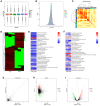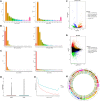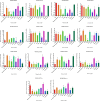Comparison of Long Non-Coding RNA Expression Profiles of Cattle and Buffalo Differing in Muscle Characteristics
- PMID: 32174968
- PMCID: PMC7054449
- DOI: 10.3389/fgene.2020.00098
Comparison of Long Non-Coding RNA Expression Profiles of Cattle and Buffalo Differing in Muscle Characteristics
Abstract
Buffalo meat consist good qualitative characteristics as it contains "thined tender" which is favorable for cardavascular system. However, the regulatory mechanisms of long non-coding RNA (lncRNA), differences in meat quality are not well known. The chemical-physical parameters revealed the muscle quality of buffalo that can be equivalent of cattle, but there are significant differences in shearing force and muscle fiber structure. Then, we examined lncRNA expression profiles of buffalo and cattle skeletal muscle that provide first insights into their potential roles in buffalo myogenesis. Here, we profiled the expression of lncRNA in cattle and buffalo skeletal muscle tissues, and 16,236 lncRNA candidates were detected with 865 up-regulated lncRNAs and 1,296 down-regulated lncRNAs when comparing buffalo to cattle muscle tissue. We constructed coexpression and ceRNA networks, and found lncRNA MSTRG.48330.7, MSTRG.30030.4, and MSTRG.203788.46 could be as competitive endogenous RNA (ceRNA) containing potential binding sites for miR-1/206 and miR-133a. Tissue expression analysis showed that MSTRG.48330.7, MSTRG.30030.4, and MSTRG.203788.46 were highly and specifically expressed in muscle tissue. Present study may be used as a reference tool for starting point investigations into the roles played by several of those lncRNAs during buffalo myogenesis.
Keywords: RNA-seq; buffalo; cattle; lncRNA; myogenesis.
Copyright © 2020 Li, Huang, Wang, Feng, Shi, Cui, Luo, Shafique, Qian, Ruan and Liu.
Figures








Similar articles
-
Buffalo long non-coding RNA gene11007 promotes myoblasts proliferation.Front Vet Sci. 2022 Aug 5;9:857044. doi: 10.3389/fvets.2022.857044. eCollection 2022. Front Vet Sci. 2022. PMID: 36032282 Free PMC article.
-
Exploring the lncRNAs Related to Skeletal Muscle Fiber Types and Meat Quality Traits in Pigs.Genes (Basel). 2020 Aug 4;11(8):883. doi: 10.3390/genes11080883. Genes (Basel). 2020. PMID: 32759632 Free PMC article.
-
Long Non-coding RNA Profiling Reveals an Abundant MDNCR that Promotes Differentiation of Myoblasts by Sponging miR-133a.Mol Ther Nucleic Acids. 2018 Sep 7;12:610-625. doi: 10.1016/j.omtn.2018.07.003. Epub 2018 Jul 9. Mol Ther Nucleic Acids. 2018. PMID: 30195797 Free PMC article.
-
A newly identified lncRNA lnc000100 regulates proliferation and differentiation of cattle skeletal muscle cells.Epigenetics. 2023 Dec;18(1):2270864. doi: 10.1080/15592294.2023.2270864. Epub 2023 Nov 1. Epigenetics. 2023. PMID: 37910666 Free PMC article.
-
Functions and Regulatory Mechanisms of lncRNAs in Skeletal Myogenesis, Muscle Disease and Meat Production.Cells. 2019 Sep 19;8(9):1107. doi: 10.3390/cells8091107. Cells. 2019. PMID: 31546877 Free PMC article. Review.
Cited by
-
Transcriptomic Changes and Regulatory Networks Associated with Resistance to Mastitis in Xinjiang Brown Cattle.Genes (Basel). 2024 Apr 7;15(4):465. doi: 10.3390/genes15040465. Genes (Basel). 2024. PMID: 38674399 Free PMC article.
-
Buffalo long non-coding RNA gene11007 promotes myoblasts proliferation.Front Vet Sci. 2022 Aug 5;9:857044. doi: 10.3389/fvets.2022.857044. eCollection 2022. Front Vet Sci. 2022. PMID: 36032282 Free PMC article.
-
Identification of long non-coding RNA-mRNA interactions and genome-wide lncRNA annotation in animal transcriptome profiling.J Anim Sci Technol. 2023 Mar;65(2):293-310. doi: 10.5187/jast.2023.e17. Epub 2023 Mar 31. J Anim Sci Technol. 2023. PMID: 37093954 Free PMC article. Review.
-
Integrated Analysis of Transcriptome and Metabolome Profiles in the Longissimus Dorsi Muscle of Buffalo and Cattle.Curr Issues Mol Biol. 2023 Dec 4;45(12):9723-9736. doi: 10.3390/cimb45120607. Curr Issues Mol Biol. 2023. PMID: 38132453 Free PMC article.
-
CircCLTH promotes skeletal muscle development and regeneration.Epigenetics. 2022 Dec;17(13):2296-2317. doi: 10.1080/15592294.2022.2117115. Epub 2022 Sep 8. Epigenetics. 2022. PMID: 36043316 Free PMC article.
References
LinkOut - more resources
Full Text Sources

